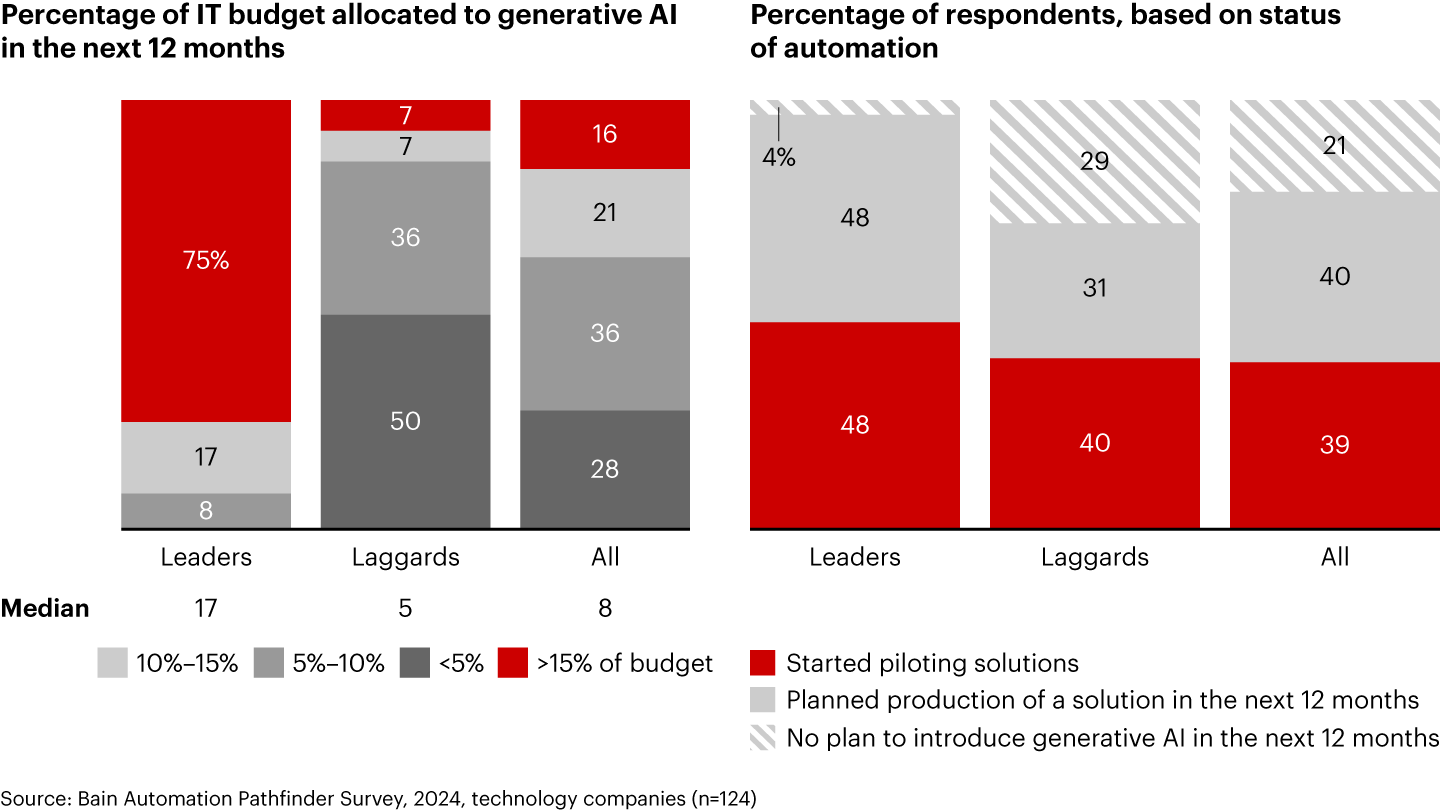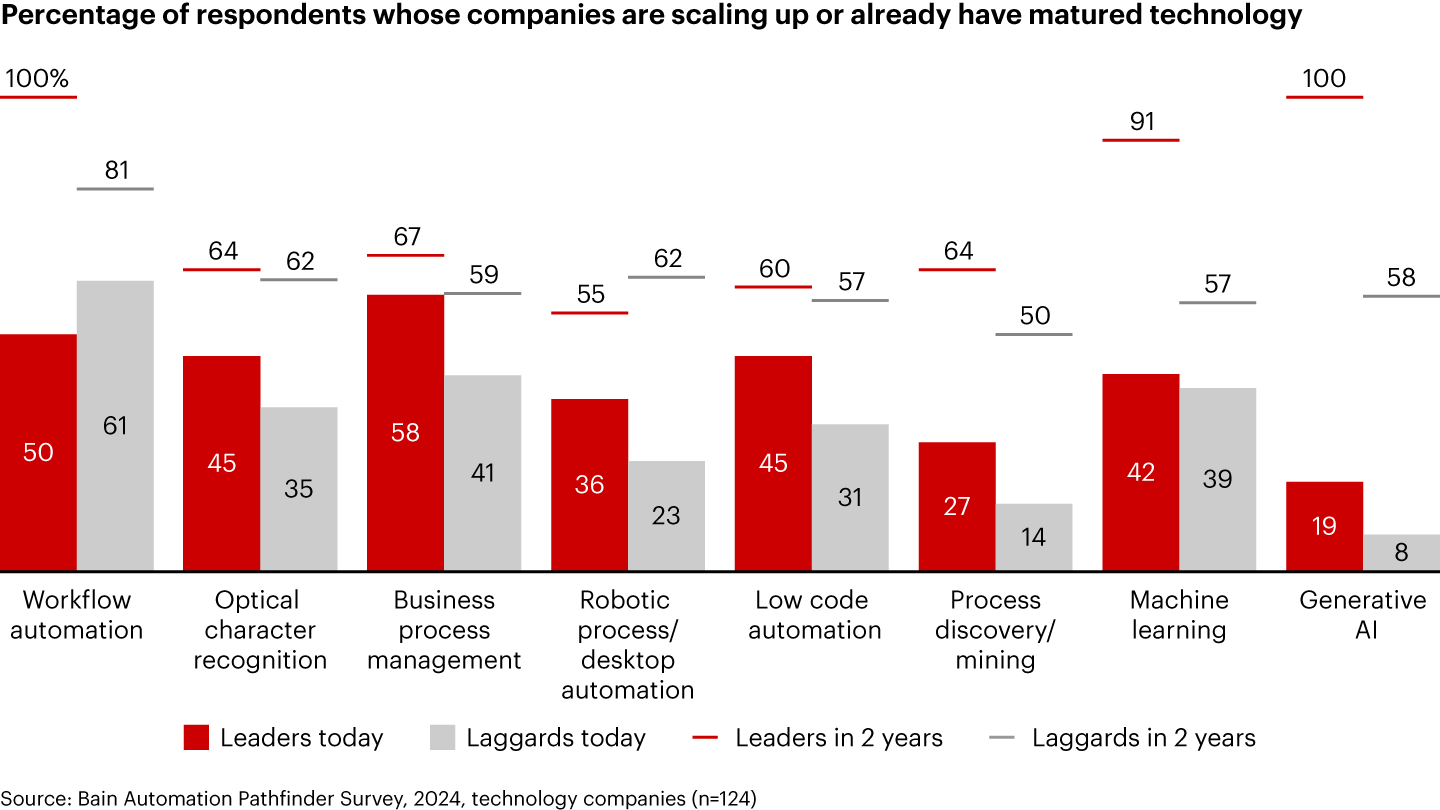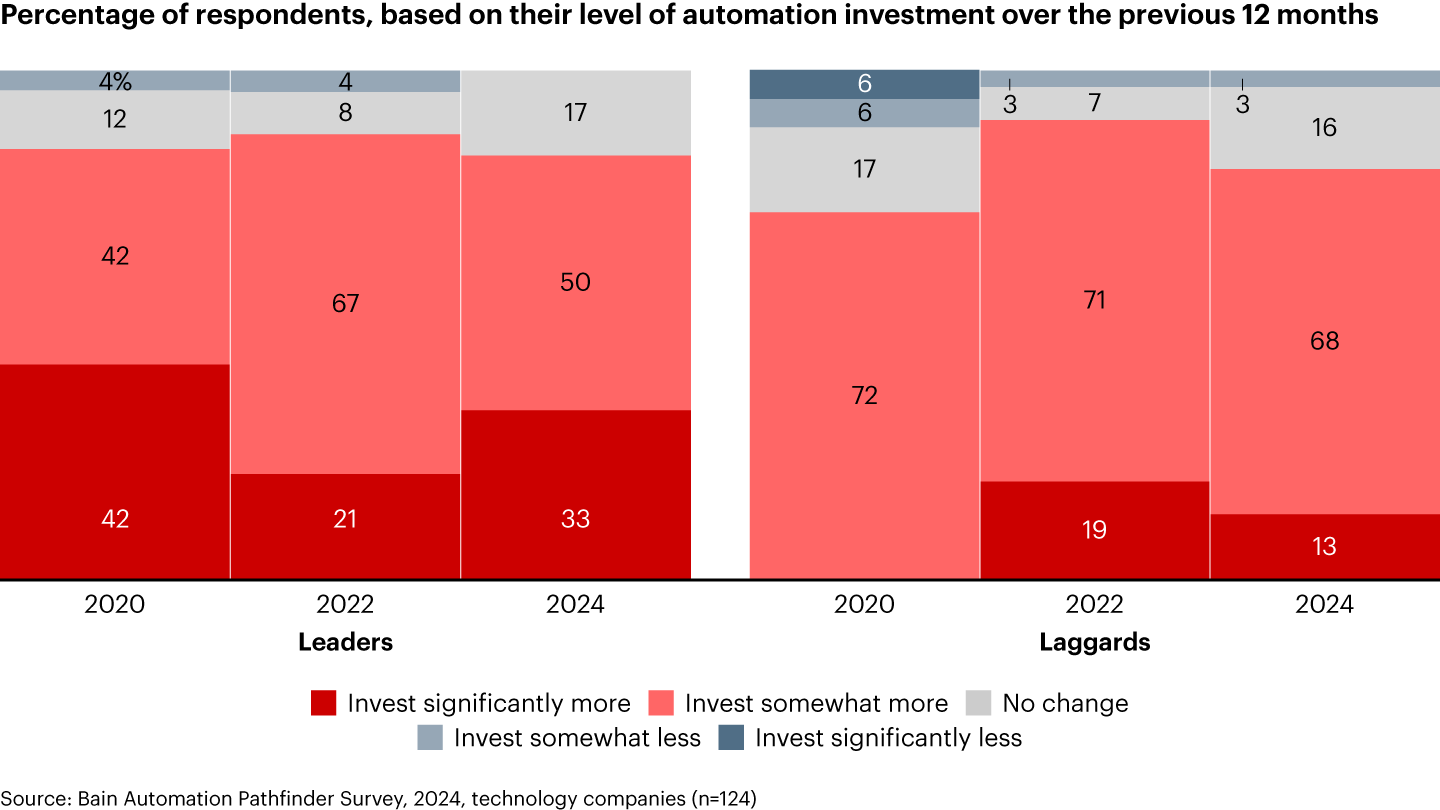Technology Report

At a Glance
- Technology companies investing most heavily in automation outperform others in savings and adoption of new disruptive technologies.
- The gap between leaders and laggards is widening as leaders increase investment as a share of IT budget.
- Leaders are planning to invest, on average, over three times more in generative AI than laggards.
- Successful automation programs include enterprise-wide rollout, combined technologies, value creation, and engaged staff.
This article is part of Bain's 2024 Technology Report.
Given Nvidia’s long history of successfully scaling up automation and artificial intelligence (AI) in its engineering work, it came as little surprise last year when the company announced it was one of the first to test generative AI for boosting the productivity of its chip designers. ChipNeMo, as Nvidia calls it, takes publicly available large language models (LLMs), trains them on Nvidia’s 30 years of data, and does some fine tuning. The resulting tools serve as a chatbot, an electronic-design-automation-tool script writer, and a summarizer of bug reports.
Written in collaboration with
Written in collaboration with

Like Nvidia, technology companies with a long track record of developing and scaling up programs in traditional forms of automation, such as robotic process automation (RPA) and analytical AI, are now applying the lessons learned to gain an early advantage in generative AI. As with traditional automation, true success comes only when pilots are converted into large-scale programs that deliver compelling returns on investment across the enterprise.
Bain’s latest survey of 893 automation executives worldwide, including 124 in technology companies, finds that companies investing most heavily in automation outperform laggards in savings achieved and adoption of new, more disruptive technologies. (We define leaders as companies investing at least 20% of their IT budget in automation in the past two years, and this elite group achieved an average 22% in cost savings. Laggards are companies investing less than 5% of their IT budget in automation, and these firms achieved just under 8% in savings on average.)
Automation leaders at technology firms were able to reduce the cost of processes by 17% in 2023, whereas lagging companies managed only 8%. Respondents also cited the benefits of trimming the number of low-value tasks, speeding up process completion time, and improving service quality and accuracy.
Consider Microsoft’s automation in finance over the years. From 2010 to 2020, Microsoft has grown revenue by 145% while growing finance headcount only 15%. AI has also made Microsoft’s finance forecasts more accurate and faster—from 100 full-time-equivalent staff spending one month to 2 full-time employees spending two days.
Now the leaders are moving quickly into implementing generative AI, and plan to invest, on average, over three times more of their IT budget in generative AI than laggards (see Figure 1).


More than cost reductions
The continued wave of automation is generating significant value. AT&T, for instance, began working with RPA in 2015, making the company one of the earliest adopters of the technology, and has been applying AI across its operations for years. AI helps AT&T to optimize field technician routes, reducing fuel consumption while serving more customers; to translate and simplify documents; and to improve coder and developer productivity.
Companies that have successfully scaled up traditional forms of automation—workflow automation, RPA, scripting, and optical character recognition—have already embedded AI outside of LLMs, such as machine learning in document processing or natural language processing in job descriptions (see Figure 2).


What’s more, the gap between leaders and laggards at technology firms has widened and will likely continue to do so, as leaders plan to raise their investment as a share of IT budget while lagging companies plan to be more conservative. In our survey, 33% of leaders plan to invest significantly more in 2024, up from 21% in 2022, compared with only 13% of laggards, down from 19% in 2022 (see Figure 3).


Generative AI will take automation to new levels of effectiveness and value. Most respondents are and will be using generative AI for three waves of use cases (see Figure 4). In the first wave, they apply the technologies to use cases that were not possible in the past, such as creating new marketing content. For the second wave, they plan to replace technologies for current use cases, including order processing. A third wave will consist of enhancing current use cases, such as accounts payable and receivable. The logic here consists of companies wanting to apply generative AI to new areas, rather than start fresh with use cases where they have already invested resources, built integrations, and trained employees.
Automation principles that apply to generative AI
Companies that master the following principles will position themselves to rapidly take advantage of generative AI.
Elevate automation from narrow pilots to cross-company strategic initiatives. One common trap is crowdsourcing a long list of small automation projects, often within individual departments, then trying to execute them one by one. This makes it difficult to achieve major savings or other benefits.
Automation leaders take a different approach. They set bold goals, framing the potential in the millions of dollars. They gain the sponsorship of senior executives and embed automation as a pillar of the overall strategic agenda.
Combine automation technologies. When individual tasks are automated with different technologies, little value results. Worse, this can add more process complexity than the automation delivers in cost savings. Instead, automation leaders often combine technologies to deliver the best results. They start with the business needs and process, working back to determine the right combination.
Insist on realizing value from automation. Before investing in the software and implementation resources to build an automation, senior executives increasingly want a commitment from the people asking for the investment to achieve savings and other benefits, along with a plan to realize that value. Once automations are deployed, executives expect business processes to be redesigned, and they insist on seeing proof of how teams achieved the value claimed.
Coax and convince to reach full adoption. Managing how employees change their behaviors can make or break an automation program. Maximizing adoption of automation tools entails documenting and educating people on the new way to work, investing in training, tracking adoption rates, and taking steps to keep improving how people use the technologies.
* * *
The level of sophistication and maturity with automation varies widely. But companies that lag can catch up if they’re willing to boost their investments and commit to a sustained effort that changes how people work.
The good news is that lessons learned from traditional automation technologies can inform fruitful deployment of new technologies, including generative AI. The techniques, governance issues, and process changes are all quite similar, so using generative AI offers a fresh approach to effectively manage costs and improve the customer experience.

About Ashling Partners
Ashling Partners is a global intelligent process automation consultancy, offering full-lifecycle services including business process discovery, design, automation, and change management. For more information visit www.ashlingpartners.com.